
05 Sep The Flowers That Changed Fashion
 Fashion has always had a fascination with flowers, but some blooms have shaped it more profoundly than mere seasonal prints. They have slipped from gardens into ateliers, altering the line of a skirt, the cut of a jacket, even the architecture of a perfume bottle. What begins as a stem in nature has a way of reappearing as a silhouette on the catwalk.
Fashion has always had a fascination with flowers, but some blooms have shaped it more profoundly than mere seasonal prints. They have slipped from gardens into ateliers, altering the line of a skirt, the cut of a jacket, even the architecture of a perfume bottle. What begins as a stem in nature has a way of reappearing as a silhouette on the catwalk.
Christian Dior built his entire aesthetic on such a premise. His New Look of 1947 was less a dress than a rose reborn in cloth — waists cinched into calyxes, skirts blossoming into peony domes. He did not treat flowers as embellishment but as blueprints. His favourite bloom, the lily of the valley, was not only embroidered into gowns but secretly tucked into seams as a good luck charm before a show. On May Day in Paris, when lily of the valley is exchanged as a symbol of joy, Dior would send sprigs to clients and friends — extending the superstition into his entire social world. His couture was not just floral in appearance; it carried the rituals of the garden inside its very lining
Chanel’s answer was altogether different. Gabrielle Chanel made the camellia her emblem — prized for its perfect symmetry and its curious lack of scent. It would never clash with her perfumes, especially No. 5, and so it became the quiet guardian of her brand. The choice was not accidental: Alexandre Dumas’s novel La Dame aux Camélias had made the flower an emblem of female independence and scandal, a coded reference that Chanel deliberately borrowed. She loved its resilience, too — unlike roses, camellias did not bruise or fade quickly when pinned to a jacket. Even today, the white camellia remains a recurring motif at Chanel shows, stitched into tweeds, enamelled on jewellery, embossed into handbags — an eternal bloom that has never left the maison.
If Dior sculpted florals and Chanel codified them, Yves Saint Laurent intellectualised them. His tulip skirts, iris gowns and poppy prints were not simply decorative; they were quotations. He borrowed lines from Van Gogh’s irises and Matisse’s cut-outs, treating the petal as a painter might treat pigment. Yet behind the atelier doors, Saint Laurent was a gardener in his own right. At his villa in Marrakech, he designed a lush landscape filled with bougainvillea and jacaranda, blossoms that reappeared as electric shades in his collections. For him, the garden was not separate from the studio — it was his laboratory of colour.
Valentino, meanwhile, leaned into unabashed romance. His gowns overflowed with roses, cascading down in crimson, blush or ivory. Seamstresses at his Roman atelier recall that vases of red roses were always kept near the cutting tables, a talisman as much as inspiration. The rose became so inseparable from Valentino that when the Metropolitan Museum staged a retrospective in his honour, it filled its halls not with mannequins but with roses — thousands of them — an exhibition that smelled as much as it dazzled.
Jeanne Lanvin, working earlier in the 1920s, approached florals with unusual technical precision. She was obsessed with colour and founded her own in-house dye laboratory to capture shades she observed at Paris flower markets. The famous “Lanvin Blue” was modelled on the exact hue of forget-me-nots in a medieval fresco she adored. Her gowns shimmered in lilac, carnation pink and cornflower blue — shades so subtle that fashion journalists of the time compared them to “the haze on a petal seen through glass.” Lanvin transformed the fleeting chemistry of flowers into permanent colour palettes.
Roberto Cavalli took florals in another direction altogether. His silks were jungles: orchids sprawled across fabric, tiger lilies colliding with animal prints. In Florence, he experimented with textile printing in the 1970s, magnifying flowers to surreal scales that seemed almost predatory. “A flower is never innocent,” he once remarked, treating blossoms as creatures rather than ornaments. His florals carried the heat of nightclubs as much as the humidity of rainforests, a sensual wilderness stitched into evening gowns.
Alexander McQueen inverted the romance, making florals tragic and sublime. His 2007 Sarabande show is remembered for models dressed in fresh flowers, which wilted visibly under the lights — a performance of time itself. McQueen drew on Dutch vanitas still-life paintings, where blossoms appeared alongside skulls and hourglasses, reminders that beauty is bound to death. Even in earlier shows, his embroidery mimicked petals fraying at the edge, as though already half-decayed. To wear McQueen’s florals was to confront both splendour and loss in a single garment.
Dries Van Noten, by contrast, is the archivist of florals. He collects antique horticultural books and botanical illustrations, often enlarging their pages into print designs. His layered fabrics — dahlias, peonies, irises drifting one over another — resemble herbaria, pressed collections of plants preserved over time. His Antwerp studio is famously papered with blown-up photographs of flowers for months before a collection, like a florist pinning stems to a wall before choosing the perfect arrangement. Van Noten treats every bloom as part of a record, proof that fashion can catalogue nature rather than simply borrow it.
From Dior’s lily of the valley charms to Chanel’s scandalous camellias, from Lanvin’s laboratory violets to Cavalli’s predatory orchids, the flowers that changed fashion are not just decorative. They carry superstitions, scandals, laboratory experiments, private gardens and painted still-lifes within them. In their petals lie entire philosophies of beauty, identity and time. Fashion, like floristry, is built on the paradox of holding onto what withers — an art of giving permanence to the fleeting, and in doing so, making it endure.
